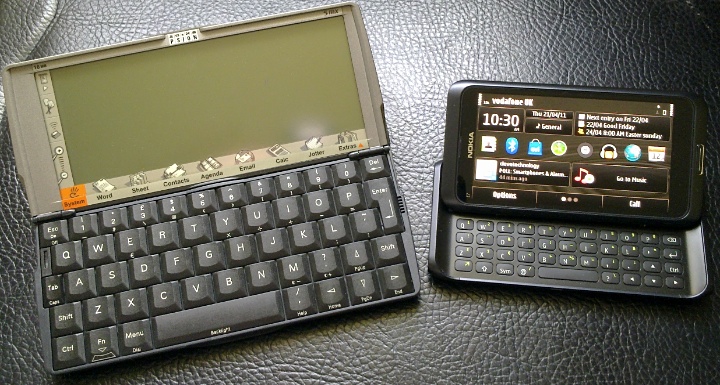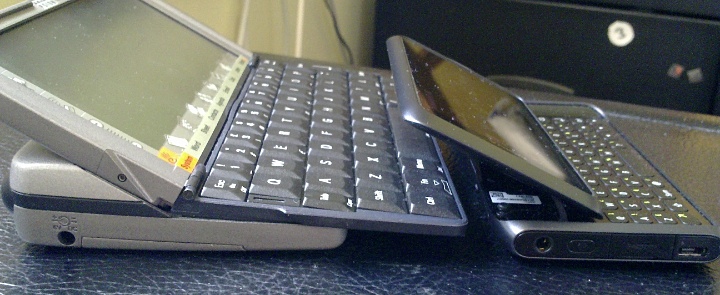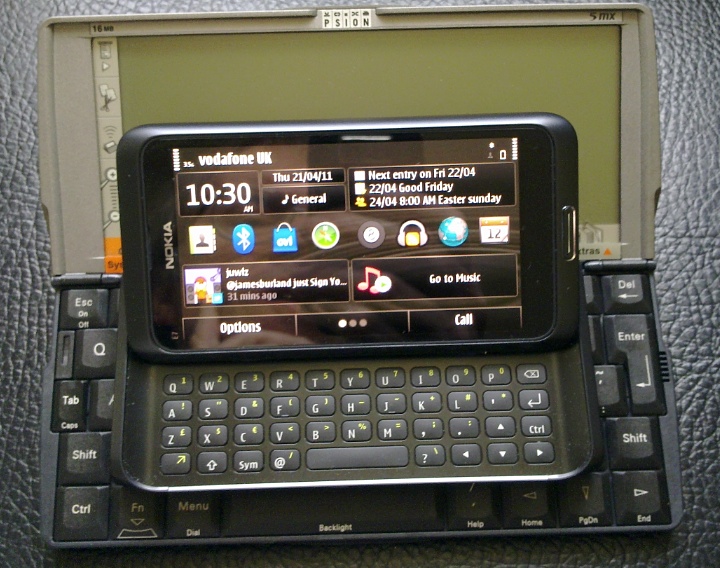In my mind I had the Nokia E7 as only slightly smaller than the Psion - it was quite a shock pulling the Series 5mx out of the drawer and putting the two side by side - the E7, one of the largest Symbian-powered devices of the modern age, is positively dwarfed by its ancient ancestor, especially in opened out mode:

Now, hear me out, I'm not suggesting that the Psion can compete with the E7, this article is, in this sense, academic. I'm simply curious in how much technology has changed in 12 years (an eternity in consumer electronics), with respect of devices with similar aims and form factors. And are there any areas where we've gone backwards?
| Psion Series 5mx | Nokia E7 | |
| Price when new | £500 | £500 (SIM-free, or £470 on pay-as-you-go) |
| Form factor and input method, build quality | Plastic clamshell palmtop with pivoting plastic resistive touchscreen on metal hinge. | Aluminium shell with pivoting Gorilla glass capacitive display on metal hinge. Incredible build quality, amazingly thin for the keyboard size |
| Display | 5.6" transflective LCD, superb in sunlight, dull indoors even with green phosphorescent backlight. 640 by 240 pixel resolution. Strictly a landscape device, has to be used 'opened' | 4" CBD AMOLED, pretty good in sunlight, 640 pixels by 360, all screens work in both portrait and landscape modes. 640 by 360 pixel resolution. |
| Keyboard | Five row extending keyboard, superb key size, separation and travel, punctuation via function and shift keypresses | Four row keyboard, nominal key travel but excellent feel, punctuation via long key presses or Fn/Sym keys |
| Weight | 354g (including AA batteries!) | 176g |
| Operating system and interface | EPOC/32, a.k.a. ER5 (EPOC Release 5) | Symbian^3, firmware updates just beginning, expecting two or three minor updates and one major update in 2011. |
| Free RAM, free user memory, expansion for apps and media | 16MB (this was enough for the running OS and for a dynamically-sized internal virtual memory disk for user data and applications!), plus CompactFlash expansion up to 2GB (in theory) - in practice, most users of the time went to 128MB or similar, at most. | Over 140MB free RAM, over 330MB free on system disk, 16GB mass memory, no expansion. The absence of microSD expansion not only limits capacity, it also takes away a means of transferring media between devices. Partly to compensate for this, a USB on the go system (via supplied adapter) means that USB sticks/disks can be connected. Not exactly elegant though. |
| Processor, chipset notes, peformance | 36MHz ARM 710T, snappy performance for all apps and instant multitasking in the graphical interface | ARM11, 680MHz, plus Broadcom BCM2727 graphics acceleration, pretty quick for most (though not all) operations |
| Use one-handed if needed | Not possible | Possible but limited, due to screen size |
| Camera | None | 8 megapixels EDoF (i.e. full focus, no macro), dual LED flash. Disappointing not to have auto-focus. |
| Camcorder | None | Excellent 720p video with digital sound |
| Application load-out highlights (out of the box) | Psion Word/Sheet office editors, comprehensive Agenda PIM application and the wonderful freeform Data database app | Ovi Maps with free navigation, Ovi Store, Quickoffice editing suite, Photo and Video editors |
| Web browsing/working on the Internet | Basic (bought-in, from STNC) web browser (by today's standards). Connections to the net were via plug-in dial-up modems, via infrared cellphones with GSM circuit data or via phones working with the new GPRS standard. Opera was installed and used by most users though, as it was faster and better. | Web as per the N97 and E90, with Flash built-in and now with multitouch support. Interface is dated and multi-stage page rendering now clumsy with 2011 Megabyte+ web pages. Still waiting for the promised next-gen Nokia browser - now promised in the imminent 'Anna' update. Opera Mobile is installed and used by most users though, as it is faster and better. |
| Messaging, Email | POP3 email client, with free IMAP4 plug-in. | Nokia Email (nee Messaging) works pretty well, albeit a little slow. Many people find bypassing Nokia's servers (by declining the terms of service) improves things a lot, using IMAP directly, but your mileage may vary. |
| Audio in and out | Tinny mono speaker, dedicated voice recording and playback buttons | 3.5mm jack output, plus tinny mono speaker |
| Maps and navigation | None, though there were some third party solutions. | Full real time voice-guided navigation for the whole world, plus extras and guides |
| Battery capacity, life | Roughly 2100mAh, depending on the type and quality of the AA batteries used, can be changed in ten seconds, two AA cells last around a week of normal use(!) AC power adapter available. | 1200mAh, fixed with no user access at all, recharge each night, microUSB charging from AC or computer |
| Connectivity notes | No telephony. Infrared, plus proprietary RS-232 (serial) data | Quad-band GSM, Pentaband 3G, Bluetooth, Wi-Fi, GPS, microUSB data |
| Security of data and of the device | All data in memory was held in place via the main AA cells and a small backup battery. If both power sources failed, data was lost and had to be restored from a backup. Master password at power up. | All data is held in flash memory and apps save their data as they go, so even a total power failure (e.g. taking the battery out) won't lose the user data. The E7 has a number of other security options, including PINs, and promised updates, detailed here. |
| Video apps and capabilities | None, storage space of the time and processor speed wasn't up to decoding video (which in itself was in fledgling form in the computer world in 1999) | Symbian^3 video player, handles H.263/H.264/AVC MP4, plus DivX, WMV and many other formats and variants. HDMI out to compatible equipment |
| Application ecosystem | Around 2000 third party applications were produced for the Psion, thanks mainly to the built-in OPL programming language | More than 10,000 third party applications, including HD GPU-aware games, weak area (by 2011 standards) is cloud service integration apps |
| Updates | A handful of minor bug fix updates were available through the 5mx's life but were invisible to the user and only applicable using special flashing equipment. | A programme of continuing updates is planned for the rest of 2011, with 'Anna' bringing portrait mode split-screen qwerty and a new browser. |

Aside from the sheer size and the way in which the hinge opens, there's a lot of similarity between the two designs, both opening to present a large screen at a pleasant angle for working, plus a very usable QWERTY keyboard. This isn't just stating the obvious for I truly believe there's something holistic that happens when you have this form factor, as I explained at length here. The Psion always felt more of a miniature computer than a humble PDA and the E7 is in much the same vein, especially presented like this. It changes the way you think of the device.
The biggest strength of the Psion Series 5 range was, of course, its keyboard, with those huge keys - the best keyboard ever put on a mobile device. In fact, it was so good that it was optimised more for 'on the desk' touch typing more than 'on the go' two thumb typing, amazingly. In contrast, the E7 (and all other modern solutions) is far easier to type on with two thumbs, with the device held in the supporting fingers.

Another area where the Psion scored and where not a single other device has ever come close is in the EPOC 'Data' application, a freeform database that was so easy to use that users managed to create Data files for just about anything. From sets of contacts to videos/DVDs to stamps to flowers. There simply hasn't been a comparable application on any platform since and it's a crying shame that Nokia chose not to port it to EPOC Release 6 for the 9210 Communicator. Data simply got left behind.
Running on two AA batteries for a week wasn't bad either, but in all other factors the modern E7 wins out, as of course it must. Although the premise of a pocket computer is still valid, the number of tasks that a user requires it to perform is far higher, whether it's playing back movies, liasing with social network contacts or navigating to the next town. And the modern user needs it to do all this in a much smaller and lighter form factor and with a much clearer and responsive colour screen.
If you too have a Psion palmtop tucked away in a drawer, why not get it out, put in fresh batteries and give us your own comments on the way in which pocket computing has changed in the last 12 to 15 years?
Steve Litchfield, All About Symbian, 22nd April 2011
